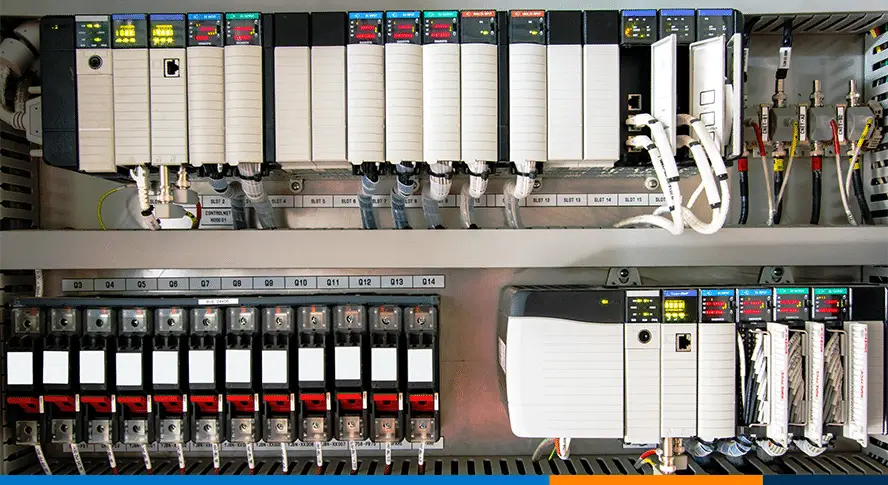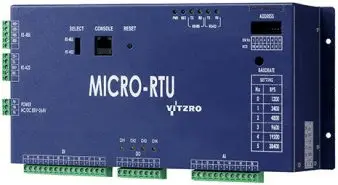This article describes the major difference between the PLC and RTU. PLC and RTU are the abbreviated forms of programmable logic controller and remote terminal unit respectively.
The major difference between PLC and RTU is that PLC controls the machine operation by reading input signals and outputting specific signals after executing the pre-determined programs. While RTU collects the machine data and sends it to the central location for analysis.
What is PLC?
PLCs are programmable logic controllers which have digital inputs, digital outputs, analog inputs, and analog outputs connected to them. PLCs communicate with the communication protocols present within them. For writing the control logic in the controllers, a software language such as ladder logic, structured text, instruction list, functional block diagrams, etc. is used.
Depending on the logic that is written in the controller, the PLC would control the outputs according to the inputs received. Communication protocols are used for communication between the other control graphic systems such as SCADA or HMI. They are also used for communicating with other controllers.

PLCs are widely used in manufacturing and process industries. PLCs are also generally used to control a process or sequence of processes like manufacturing or an assembly line.
Advantages of PLC
- PLC makes use of the latest technology. So it can perform functions like relay switching, timing, counting, comparing, calculating, etc.
- PLC uses standard protocols for communication.
- PLC is more reliable than RTU.
- It is easy to upload and download programs on a PLC control system. The program logic is contained in the PLC memory. So there are no wiring errors.
- Without rewiring, it is possible to edit, create or delete a program in a PLC.
- PLCs are easy to install and operate.
- PLC gives fast operation while managing real-time results.
- Troubleshooting is easy in PLC.
Disadvantages of PLC
- To gain optimum efficiency and effectiveness, a trained operator is needed.
- The whole logic function is set by the manufacturer and cannot be changed easily.
- PLC needs regular maintenance in order to keep it working in good condition.
- PLC is expensive compared to RTU.
What is RTU?
The remote terminal unit RTU is a type of PLC that is compact in size. The RTU monitor and control a process at a remote location. RTU is used in industrial areas where conditions are too harsh or too dangerous for people to be present there.

RTU may also be used when a process in a large area needs to be monitored or controlled. RTU can monitor and control all parameters like temperature, pressure, speed of the motor, etc. They are also used for activating or deactivating equipment based on some preset conditions.
Advantages of RTU
- RTU has low power consumption.
- RTU can work in harsh environments.
- In cases where there is a need to reduce power consumption, RTU can work on event-triggered cycles. This means RTU can transmit data only when a request is received from the client.
Disadvantages of RTU
- RTU units are expensive to install and maintain.
- RTU uses older technology.
- RTU is comparatively not so good in terms of processing power and data storage.
Applications of PLCs and RTUs
PLCs are the central unit of process control, or we can say it is a workhorse of any industrial installation. The RTUs find their applications in remote data monitoring.
PLCs communicate with all types of electric sensors, motors, field instruments, control valves, energy monitoring devices, and other equipment that are part of the automation system. PLCs control the operation like speed control of the DC motor, mixing liquids, opening, closing, and regulation of the control valve. PLCs can also read the analog signals from the resistance temperature detectors to monitor and control temperature.
On the other hand, RTUs are used to collect data from remote locations. RTUs collect the data from devices around a wide area network like wind turbines, solar systems, and water pumps. The collected data is then sent to the central location for further monitoring and analysis. The data can be used to imitate the alarm or used to control of remote devices.
Difference between PLC and RTU
| Parameter | PLC | RTU |
| Ruggedness | PLCs are less rugged and resistant to harsh environments. | PLCs have higher energy consumption. |
| Power Consumption | In an RTU, only the requested data and the changes are communicated. | The energy consumption of RTUs is very less. |
| Data Transfer Speed | The speed of data transfer in RTU is lower as compared to a PLC. In RTU, only requested data and changes need to be communicated. Therefore, RTU has a lower data transfer speed. | The speed of data transfer in a PLC is higher as compared to an RTU because all the process data and programming data are communicated in a PLC. |
| Data Communication | An RTU can work with any process voltage. | In a PLC, all the process data and programming data are communicated. |
| Program driven method | In a PLC, programs are driven in a cyclic manner. | In an RTU, programs are driven in an event manner, that is, it is trigger based. |
| Power Supply | Typically, a PLC works on 24 V DC or 230 V AC. | SCADA is generally used with RTU because RTU does not have an in-built display and limited programming control. |
| Programs and operating systems | PLC can be programmed with a computer. | RTU uses proprietary software. RTU can be programmed remotely or on-site. |
| SCADA connectivity | SCADA is generally used with RTU because RTU does not have an in-built display and limited programing control. | PLC does not essentially require a SCADA. |
Conclusion
RTU and PLC are two types of controllers used to control the process. As discussed above, both have their own specific functions and a particular type of controller – RTU or PLC, can be selected as per the user’s applications.
If you need to control the machine operation by a predefined program, PLC is a good choice, and if you need to control the machine after analyzing the data then the RTU is the right choice.
This was very much Educational and helpful. Ican rate you 5 over 5